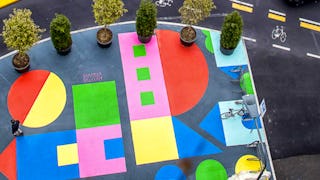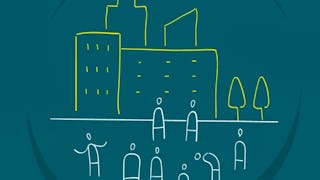In Reclaiming the Street, you will learn about the mechanisms of change and will be challenged to apply this knowledge to start creating vibrant streetscapes in your neighbourhood. This six week course will guide you through seminal academic work on the topics of transition management and street experiments while providing practical insights from practitioners from around the world. A final peer-reviewed project integrates key takeaways from each module of this course to help you write an actionable plan for change.



Reclaiming the Street for Livable Urban Spaces



Instructors: Anna Nikolaeva
10,631 already enrolled
Included with 
(79 reviews)
What you'll learn
Explore the street as a space for experimentation and an arena for transitioning towards a new mobility paradigm
Understand how tactical urbanism can be deployed for maximum effectiveness in changing the streetscape
Articulate the relationship between citizen activism and the bureaucratic structure
Re-imagine the street as a space for people rather than infrastructure for moving traffic
Skills you'll gain
Details to know

Add to your LinkedIn profile
12 assignments
See how employees at top companies are mastering in-demand skills


Earn a career certificate
Add this credential to your LinkedIn profile, resume, or CV
Share it on social media and in your performance review

There are 6 modules in this course
In the wake of the COVID-19 pandemic, we have seen changes to the streetscape happening in cities all around the world. While the fast pace of these changes is promising for building a world less dependent on automobiles, one unanswered question remains: Are these renewed streets here to stay? In this module, we introduce you to the "transitions framework" to understand how change happens in the mobility system at different scales in society, As we progress through this course, your understanding of this framework will help you identify where your efforts can be best applied in creating change.
What's included
3 videos2 readings2 assignments1 discussion prompt1 plugin
How do experiments play out on the street? You will be pleased to discover that creating change in public space can be a bottom-up process driven by temporary initiatives. We examine how temporary experiments can then be solidified into policies and permanent street changes after a successful experiment concludes. Oakland, USA and Milan, Italy are two places where policy makers have announced ambitious plans to transform their streets after witnessing a high level of political support for their experimental initiatives.
What's included
2 videos2 readings3 assignments1 discussion prompt
What happens when citizens encounter a bureaucracy? It is no easy feat to instill a system level change in large systems, whether it is government or another large technocratic organization. But even the largest bureaucracies are staffed by individual people, just like you and me. Where front-line individuals of an organization meet their constituents, the results can be particularly interesting. With certain rules and procedures in place, street-level professional have to be creative in how they navigate the conservative system world in order to create change that matters in the dynamic living world. We go to France to understand how activist groups have deployed their tactics to create change in the bureaucracy.
What's included
4 videos1 reading2 assignments1 discussion prompt1 plugin
What is the role of traffic in our cities? While mobility (virtual and physical) is essential to accessing opportunity, is it possible to achieve mobility without traffic? In this block, you will read an academic paper that visits five cities around the world to explore creative solutions to the problem of traffic. In doing so, we find that by moving people more efficiently, we are able to repurpose the reclaimed space for more valuable uses, even in the middle of a highway. As it turns out, changing the way we talk about traffic, especially moving away from utilitarian language, is a powerful way to change perceptions of traffic for yourself and others.
What's included
4 videos3 readings3 assignments1 discussion prompt
What can individuals do to change the system? As it turns out, a connected group individuals united in a common goal is far more effective at creating change than any one person alone. You will read about how activists in London and Amsterdam leverage their internal and external relationships to mediate between themselves and the bureaucracy. We then go to New York for a reminder that traffic is not carved in stone. It is a clear sign of change when streets are eerily empty in a famous city known for its gridlock traffic.
What's included
3 videos3 readings2 assignments1 discussion prompt
What's included
1 peer review
Instructors



Recommended if you're interested in Governance and Society


Technical University of Munich (TUM)


Università Bocconi


University of Amsterdam


Johns Hopkins University
Why people choose Coursera for their career




Learner reviews
79 reviews
- 5 stars
79.74%
- 4 stars
12.65%
- 3 stars
3.79%
- 2 stars
3.79%
- 1 star
0%
Showing 3 of 79
Reviewed on Nov 2, 2020
Great course material and assignments, definitely worth the time and effort
Reviewed on Jan 7, 2021
Excellent course really grew my knowledge of the area and learnt lots of new insights and open my perspective to new ways of thinking. Highly recommend
Reviewed on Jan 7, 2023
Very high quality course with strong theoretical foundation and examples from real world.

Open new doors with Coursera Plus
Unlimited access to 10,000+ world-class courses, hands-on projects, and job-ready certificate programs - all included in your subscription
Advance your career with an online degree
Earn a degree from world-class universities - 100% online
Join over 3,400 global companies that choose Coursera for Business
Upskill your employees to excel in the digital economy
Frequently asked questions
Access to lectures and assignments depends on your type of enrollment. If you take a course in audit mode, you will be able to see most course materials for free. To access graded assignments and to earn a Certificate, you will need to purchase the Certificate experience, during or after your audit. If you don't see the audit option:
The course may not offer an audit option. You can try a Free Trial instead, or apply for Financial Aid.
The course may offer 'Full Course, No Certificate' instead. This option lets you see all course materials, submit required assessments, and get a final grade. This also means that you will not be able to purchase a Certificate experience.
When you purchase a Certificate you get access to all course materials, including graded assignments. Upon completing the course, your electronic Certificate will be added to your Accomplishments page - from there, you can print your Certificate or add it to your LinkedIn profile. If you only want to read and view the course content, you can audit the course for free.
You will be eligible for a full refund until two weeks after your payment date, or (for courses that have just launched) until two weeks after the first session of the course begins, whichever is later. You cannot receive a refund once you’ve earned a Course Certificate, even if you complete the course within the two-week refund period. See our full refund policy.
More questions
Financial aid available,



